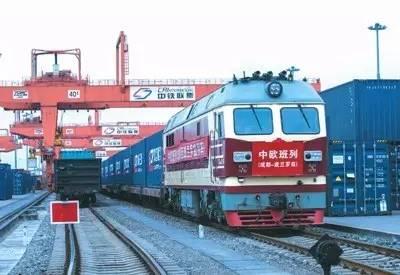
BEIJING, Jan. 2 (Xinhua) -- The Belt and Road Initiative has created an unprecedented opportunity for the development of China-Europe freight trains, and turned to a new page for the international development of China's railway logistics.
Since starting operations in March 2011, China-Europe freight trains have developed comprehensive advantages including being safe and convenient, green and environmental-friendly and hardly affected by the environment, thus becoming a key means of land transport for international logistics.
According to statistics released by China Railway, by the end of October 2017, 57 China-Europe freight train lines had been launched and more than 6,000 trains had been dispatched, from 35 Chinese cities to 34 countries in 12 European countries.
China-Europe freight trains include all international container freight trains between China, Europe and the countries along the Belt and Road dispatched by fixed run, line and schedule.
Eurasia, to the west of East Asia Economic Circle and the east of developed Europe Economic Circle, occupies 75 percent of the world's population and about 60 percent of the world's GDP. The countries along the Belt and Road differ in resource endowment, are economically complementary and have robust logistics demand.
"The number of China-Europe freight trains has soared above 3,000 in 2017 alone, equivalent to the sum dispatched from 2011 to 2016," said a senior manager of China Railway who believes everything is improving, including time limit of arrival, logistics costs, types of goods or return trains.
China-Europe freight trains run 1,300 kilometers daily on average and its shortest time to arrive in Europe is 12 days, three times faster than ships. The full-process costs of China-Europe freight trains have been reduced by more than 30 percent compared to those at the beginning of operation, only one fifth of air freight cost. Meanwhile, a wide variety of goods have been transported. "Particularly, small commodities transported from Yiwu,known as a 'world supermarket', to Madrid have been sold to the most of Europe to make Madrid a distribution center for Yiwu's small commodities," said the manager.
Since the first China-Europe freight train was dispatched on November 18, 2014, nine such trains have been dispatched from Yiwu to Madrid, Russia, Belarus, Latvia, London, five Central Asian countries, Iran and Afghanistan. Five logistics distribution points and eight overseas warehouses have been established along relevant railway lines, covering 34 countries.
When trains transported large quantities of goods to Europe, the quantities of goods transported by return trains have also grown rapidly with an averaged annual growth of 352 percent since 2014 said the manager.
According to data from the Freight Division of China Railway Lanzhou Bureau Group Co., Ltd., 82 China-Europe and China-Asia freight trains loaded with 6,136 TEUs dispatched from and arriving at Zhongchuan North Railway Station in Lanzhou New Area contain 147,000 tons of imported goods worth 180 million U.S. dollars, including refrigerated containers, high-carbon chromium alloy, electrolytic copper and timber.
Since "Lanzhou" China-Asia international freight train was operational in 2015, Zhongchuan North Railway Station has successively dispatched "Lanzhou-Hamburg-Lanzhou" China-Europe round-trip freight train and "Herne-Lanzhou New Area" refrigerated container train, carried out economic and trade cooperation with nearly 40 countries including Russia and Germany, and sold products of nearly 20 enterprises to countries and regions in Europe, Central Asia and West Asia.
China-Europe (Moscow-Xiamen) import freight train loaded with 41 TEUs of Russian wood panels left Manchuria Railway Station on December 5, marking the first China-Europe freight train returning to Xiamen via Manchuria port station.
The return train will be dispatched every ten days in 2018, said Lai Jinqian, manager of the Project Department of Xiamen Haitou Logistics Co., Ltd.
The number of China-Europe freight trains is growing and international cooperation is increasing. In April 2017, under the auspices of China Railway, railway departments in seven countries including China, Belarus, Germany, Kazakhstan, Mongolia, Poland, and Russia signed the Agreement on Deepening China-Europe freight Train Cooperation.
The China-Europe freight train, as a "steel camel caravan" on the new Silk Road in the new era is gradually becoming a world-renowned logistics brand. On June 8, 2016, China Railway started to use the logo of the China-Europe freight train, and initiated the China-Europe freight Train Transport Coordination Committee in association with seven Chinese logistics platforms, to improve operation quality and efficiency.(Edited by Yang Yifan, yangyifan@xinhua.org)




 A single purchase
A single purchase









